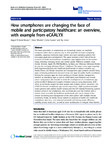How smartphones are changing the face of mobile and participatory healthcare: an overview, with example from eCAALYX
| dc.contributor.author | Boulos, M | |
| dc.contributor.author | Wheeler, S | |
| dc.contributor.author | Tavares, C | |
| dc.contributor.author | Jones, Ray | |
| dc.date.accessioned | 2017-03-29T09:03:39Z | |
| dc.date.available | 2017-03-29T09:03:39Z | |
| dc.date.issued | 2011 | |
| dc.identifier.issn | 1475-925X | |
| dc.identifier.issn | 1475-925X | |
| dc.identifier.other | ARTN 24 | |
| dc.identifier.uri | http://hdl.handle.net/10026.1/8729 | |
| dc.description | The latest generation of smartphones are increasingly viewed as handheld computers rather than as phones, due to their powerful on-board computing capability, capacious memories, large screens and open operating systems that encourage application development. This paper provides a brief state-of-the-art overview of health and healthcare smartphone apps (applications) on the market today, including emerging trends and market uptake. Platforms available today include Android, Apple iOS, RIM BlackBerry, Symbian, and Windows (Windows Mobile 6.x and the emerging Windows Phone 7 platform). The paper covers apps targeting both laypersons/patients and healthcare professionals in various scenarios, e.g., health, fitness and lifestyle education and management apps; ambient assisted living apps; continuing professional education tools; and apps for public health surveillance. Among the surveyed apps are those assisting in chronic disease management, whether as standalone apps or part of a BAN (Body Area Network) and remote server configuration. We describe in detail the development of a smartphone app within eCAALYX (Enhanced Complete Ambient Assisted Living Experiment, 2009-2012), an EU-funded project for older people with multiple chronic conditions. The eCAALYX Android smartphone app receives input from a BAN (a patient-wearable smart garment with wireless health sensors) and the GPS (Global Positioning System) location sensor in the smartphone, and communicates over the Internet with a remote server accessible by healthcare professionals who are in charge of the remote monitoring and management of the older patient with multiple chronic conditions. Finally, we briefly discuss barriers to adoption of health and healthcare smartphone apps (e.g., cost, network bandwidth and battery power efficiency, usability, privacy issues, etc.), as well as some workarounds to mitigate those barriers. | |
| dc.description.abstract |
The latest generation of smartphones are increasingly viewed as handheld computers rather than as phones, due to their powerful on-board computing capability, capacious memories, large screens and open operating systems that encourage application development. This paper provides a brief state-of-the-art overview of health and healthcare smartphone apps (applications) on the market today, including emerging trends and market uptake. Platforms available today include Android, Apple iOS, RIM BlackBerry, Symbian, and Windows (Windows Mobile 6.x and the emerging Windows Phone 7 platform). The paper covers apps targeting both laypersons/patients and healthcare professionals in various scenarios, e.g., health, fitness and lifestyle education and management apps; ambient assisted living apps; continuing professional education tools; and apps for public health surveillance. Among the surveyed apps are those assisting in chronic disease management, whether as standalone apps or part of a BAN (Body Area Network) and remote server configuration. We describe in detail the development of a smartphone app within eCAALYX (Enhanced Complete Ambient Assisted Living Experiment, 2009-2012), an EU-funded project for older people with multiple chronic conditions. The eCAALYX Android smartphone app receives input from a BAN (a patient-wearable smart garment with wireless health sensors) and the GPS (Global Positioning System) location sensor in the smartphone, and communicates over the Internet with a remote server accessible by healthcare professionals who are in charge of the remote monitoring and management of the older patient with multiple chronic conditions. Finally, we briefly discuss barriers to adoption of health and healthcare smartphone apps (e.g., cost, network bandwidth and battery power efficiency, usability, privacy issues, etc.), as well as some workarounds to mitigate those barriers. | |
| dc.format.extent | 24- | |
| dc.format.medium | 1 | |
| dc.language | en | |
| dc.language.iso | en | |
| dc.publisher | Springer Science and Business Media LLC | |
| dc.subject | Cell Phone | |
| dc.subject | Computers, Handheld | |
| dc.subject | Delivery of Health Care | |
| dc.subject | Geographic Information Systems | |
| dc.subject | Humans | |
| dc.subject | Internet | |
| dc.subject | Monitoring, Physiologic | |
| dc.subject | Software | |
| dc.title | How smartphones are changing the face of mobile and participatory healthcare: an overview, with example from eCAALYX | |
| dc.type | journal-article | |
| dc.type | JOUR | |
| plymouth.author-url | http://www.biomedical-engineering-online.com/content/10/1/24 | |
| plymouth.issue | 1 | |
| plymouth.volume | 10 | |
| plymouth.publication-status | Published | |
| plymouth.journal | BioMedical Engineering OnLine | |
| dc.identifier.doi | 10.1186/1475-925x-10-24 | |
| plymouth.organisational-group | /Plymouth | |
| plymouth.organisational-group | /Plymouth/Faculty of Health | |
| plymouth.organisational-group | /Plymouth/Faculty of Health/School of Nursing and Midwifery | |
| plymouth.organisational-group | /Plymouth/REF 2021 Researchers by UoA | |
| plymouth.organisational-group | /Plymouth/REF 2021 Researchers by UoA/UoA03 Allied Health Professions, Dentistry, Nursing and Pharmacy | |
| plymouth.organisational-group | /Plymouth/Research Groups | |
| plymouth.organisational-group | /Plymouth/Research Groups/Institute of Health and Community | |
| plymouth.organisational-group | /Plymouth/Users by role | |
| plymouth.organisational-group | /Plymouth/Users by role/Academics | |
| dc.publisher.place | England | |
| dcterms.dateAccepted | 2011-04-05 | |
| dc.identifier.eissn | 1475-925X | |
| dc.rights.embargoperiod | Not known | |
| rioxxterms.versionofrecord | 10.1186/1475-925x-10-24 | |
| rioxxterms.licenseref.uri | http://www.rioxx.net/licenses/all-rights-reserved | |
| rioxxterms.type | Journal Article/Review |


